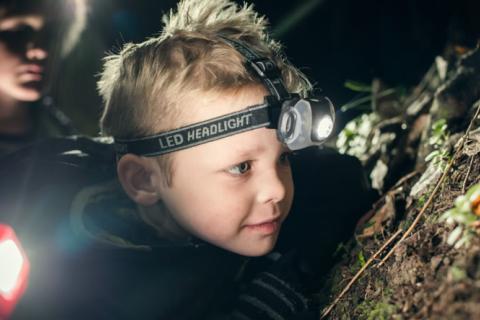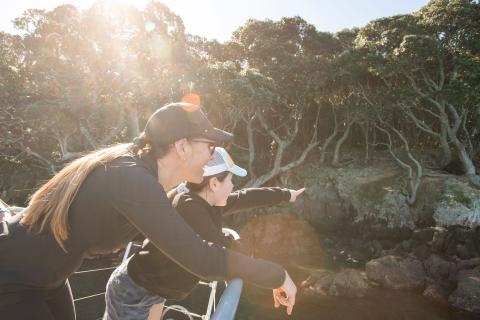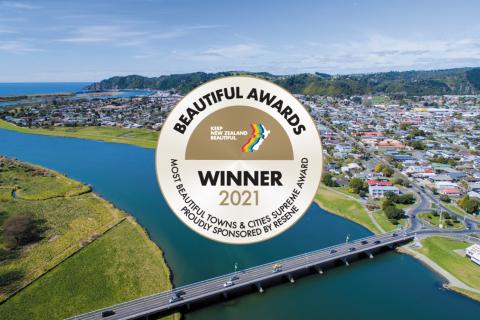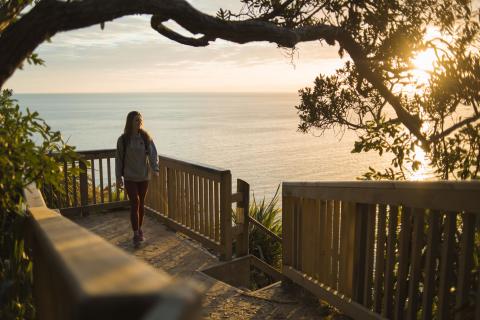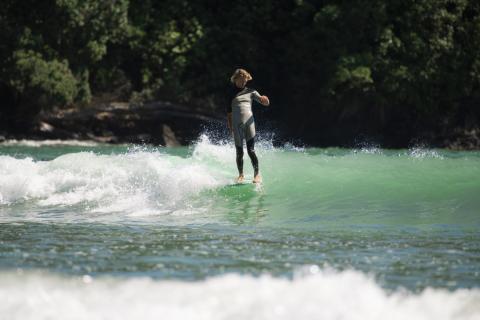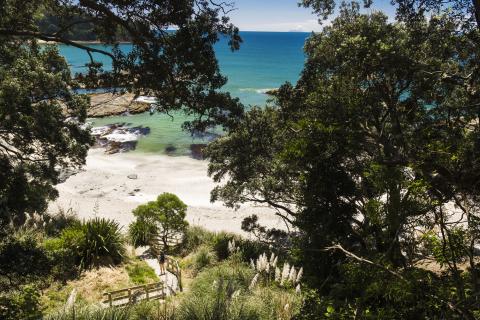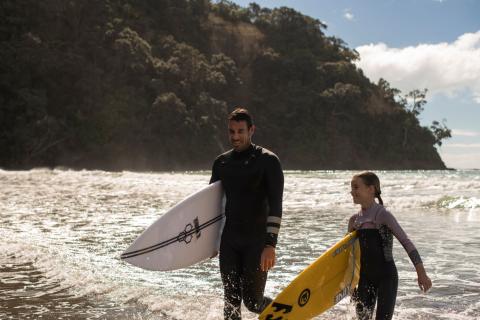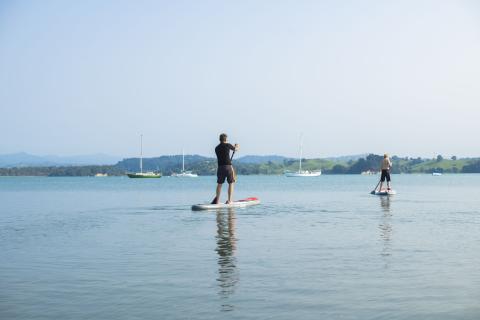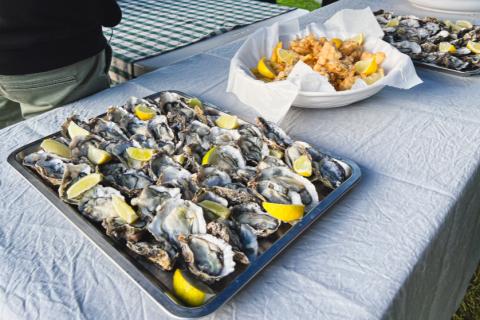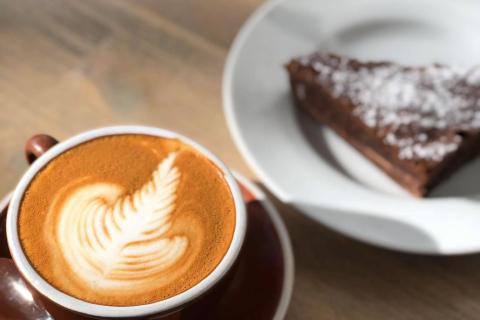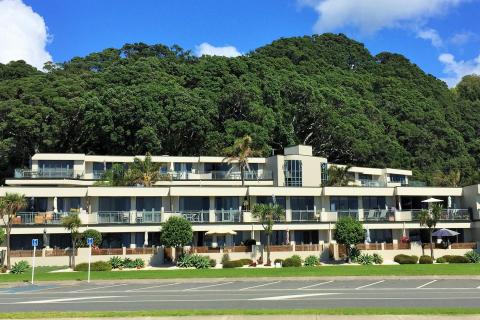
A Change of Scene
Explore the laid-back Bay of Plenty region known for its stunning coastline, unique wildlife and top kai.
This article first appeared in Kia Ora magazine, Autumn 2024. Story by Sue Moffat.
NIGHT LIFE
In the Whakatāne area is a squawking, shrieking, psychedelic affair. Late-night dance venues may be in short supply in the Eastern Bay of Plenty town but there is plenty of after-dark action a few minutes’ drive from the town centre. And more again just back from two of New Zealand’s most beloved beaches.
Last count, about 350 North Island brown kiwi were living in scenic reserves scattered between Whakatāne and the wide, white sandy expanse of neighbouring Ōhope Beach. The endangered birds also nest in hills behind fetching Ōtarawairere Bay and they occasionally appear amidst shrubbery in private back yards. Little wonder the town has claimed “kiwi capital of the world” status.
Every Friday from April through July, Whakatāne Kiwi Trust hosts night walks into kiwi territory. While visitors should not expect to see the notoriously people-shy national bird, they are highly likely to hear a distinctive “kee-wee” call after sunset. Booming weka and the haunting cry of a ruru can also be heard, mere metres from suburbia. However, it’s a bundle of small metal tubes that transforms this evening adventure into something verging on hallucinogenic.
When trust volunteer Stewart Sutton offers ultraviolet torches to participants, he explains the hand-held lights mimic the way the forest appears to nocturnal critters. Under his guidance, an entire universe is exposed. Fungal wonders emerge as tiny orange toadstools and pinpricks of iridescence amidst dark leaf litter, or smears of bright yellow across a log. Shine the beam this way and previously invisible spiders and wēta are suddenly, startlingly fluorescent blue. Point the torch that way and the dangling filaments of a glow-worm are brighter than the bug itself.
ALL ABOARD
No flashlights are needed to spot island inhabitants north of the Whakatāne river mouth. Dozens of fat kekeno (fur seals) loll on rocks and glide through astoundingly clear water to greet daytime visitors as the Moutohorā Island Tours catamaran nears its destination, a 15-minute boat ride from the mainland. Tours to the pest-free island sanctuary begin on the mainland, inside a rustic wharfside caravan where biosecurity checks require that all bags are emptied and shaken free of debris, seeds and fruit. A footwear-disinfecting bath further protects the island’s precious residents.
Once ashore, the guide points out geckos, kākāriki (parakeet) and plenty of charming tīeke (saddleback) birds with distinctive reddish-orange slashes across their backs. Then she halts and hushes the group as a small female tuatara pops out of her burrow metres from the track, a tiny spiny dinosaur emerging from another age. “It’s like being in a David Attenborough documentary,” says one delighted young Englishman.
Visitors learn which leaf to ingest for an upset stomach and to watch for ankle-bending holes where some of the estimated 100,000 tītī (muttonbirds) swoop in to nest each night. Colourful tales describe early Māori seafarers, the island’s ecological history, and failed business ventures like the whaling station that didn’t see a whale. A lookout point reveals Whakaari White Island, puffing away on the horizon.
The half-day tour includes a chance to dig your own hot tub or swim at pretty, pōhutukawa-skirted Onepū Bay, where fiercely hot underwater streams lie just beneath the sand. Think Coromandel’s Hot Water Beach, without the crowds.
Captain David Plews is a master at spotting sea life. He can find a lone penguin or a hammerhead shark and wax lyrical about the feeding habits and 145kph diving speed of an Australasian gannet. He circumnavigates the island to point out rock archways and towering, nature-carved stone sculptures of a cathedral or an elephant drinking from the ocean.
TRAIL MIX
Back on the mainland, explore the friendly, vibrant business district in what may be the nation’s best large town. Whakatāne was awarded that status last year by Keep New Zealand Beautiful, with special mention made of its environmental restoration work and the dedication and passion of its people.
On the edge of town, steps lead uphill to the Ngā Tapuwae o Toi walkway. In earlier centuries, when this promontory was strung with dwellings and gardens and palisades, the elevated views offered a strategic defensive advantage. The outlook is no less spectacular now, over river and ocean, beach and craggy cove, then stretching away to the blue smudge of East Cape. This coastal section of the walkway meanders through regenerating native bush and former pā sites, including one of New Zealand’s oldest, before dropping onto Ōtarawairere Beach. There is no road access into the secluded bay, most recently named New Zealand’s best “hidden gem” beach, and it can only be crossed on foot when tides allow.
A major slip has closed the main trail, but a detour leads uphill to Ōtarawairere village, created to house American and Finnish paper-mill staff in the 1950s and 60s. Around the same time, the beach featured in a 1954 Hollywood movie called The Seekers.
From the village, walkers can continue to Ōhope, the swimming and surfing magnet that has been crowned the nation’s best family beach three years running. Kiwi birds also live close to the western end of Ōhope, where a narrow bead of road and baches separates steep bush-clad cliffs from the sea.
This sheltered corner of the beach is an ideal learn-to-surf location, with a surf school whose friendly instructors are renowned for easing newcomers onto a board. Salt Spray Surf School has a serious safety focus and supplies everything from wetsuits to sunscreen – and a perfectly timed push to help catch a wave. It’s an exhilarating way to start the day.
FRESH FINDS
The coastal playground continues east for another 11km, where the beach ends in a links golf course and a boat ramp at the entrance to Ōhiwa Harbour. This protected waterway attracts about 70 bird species as well as a kayakers, sailors, paddleboarders, anglers and gaggles of children who take turns leaping off the redeveloped wharf.
The harbour is also home to a family-run oyster-farming enterprise with impressive sustainability and community goals. Tio Ōhiwa owners Wini and Simon Geddes employ and train local rangatahi (young people) and plan to expand the existing operation to include mussel farming and an upgraded seafood and takeaway shop.
In the meantime, the roadside takeaway stand sells freshly shucked oysters and marinated fish, with mussels and salmon fins that have been smoked on site. Guests who take the Tio Ōhiwa boat cruise are treated to a kaimoana (seafood) spread and a tour of the humble processing facility that overlooks darting stingrays and a farm of more than two million oysters. Passengers are encouraged to try shucking, and those who love eating raw bivalves will find there’s no downside to a poorly opened oyster.
The tour is lively, educational and rich in storytelling that doesn’t shy away from mentioning some past injustices against Māori. At one point almost 100 pā were dotted around the harbour, long cherished for its abundant seafood and wildlife. Expect to see a shark-spawning ground, favourite family camping areas and historic settlement sites while circumnavigating Ohakana Island, before returning to Port Ōhope Wharf.
Eat
CAFE AWA
A tucked-away location doesn’t stop daily queues forming at this great little daytime eatery. The breakfast menu is supplemented by plenty of counter fare including stellar salads, like the Cuban grilled pineapple.
This is also the home of the wickedly good oaty ginger cookies that are dished out on the return journey from Moutohorā Island. Say yes to one of those.
CIGOL
They’re doing everything right at this owner-operated restaurant, which promises Korean-based cuisine with a Pacific twist, in downtown Whakatāne. Friendly service, with addictive fried chicken thighs with a sticky sauce. The bibimbap hot stone bowl is a beautifully balanced standout, with wok-tossed kimchi and gochujang.
FISHERMAN’S WHARF CAFE
Opening hours are limited, but this is a grand spot to tuck into generous servings of tender lamb rump with a pile of wilted greens. It’s busy, so book ahead to watch sunset paint the harbour pink from the very edge of Port Ōhope Wharf or see morning paddlers during occasional Sunday brunches. Wooden floors, cushion-strewn window seating and a laid-back vibe.
Sleep
BEACHPOINT APARTMENTS
The location is unbeatable. Directly across the road from Ōhope Beach, it’s also a stone’s throw from a couple of eateries, a great gallery and bush-walking options. Ask for one of the recently upgraded beachfront rooms. The interior courtyard boasts an outdoor pool, shower and bean bags and there are plenty of thoughtful extras for guests, too, like piles of boogie boards, books and games. beachpointapartments.co.nz
Shop
GEORGE STREET LINEN
Sheets, robes and high-quality towels, designed in Whakatāne. Owner Greg Davidson lived in New York, Paris, Shanghai and Sydney before returning to his home town to launch his specialty bed linen business. The flagship George Street Linen store is just around the corner from the company headquarters, in a renovated historic building that was formerly a mechanic’s workshop. There are stores in Auckland and Australia, too.
4 ART SAKE
Good luck getting out of this Ōhope Beach gallery and gift store empty handed. There’s a focus on quality original art, plus quirky delights and homewares.
MEADOW CLUB
This recently opened Whakatāne florist shop sells lovely bouquets. They also stock a range of quality Kiwi skincare products from the likes of Aleph Beauty and Becca, as well as Bo & Ko Baby products and locally made raw sweet treats.
Getting there
Air New Zealand operates non-stop flights to Tauranga from Auckland, Wellington and Christchurch, with connections across the domestic network. Whakatāne is a one-hour drive from Tauranga.
